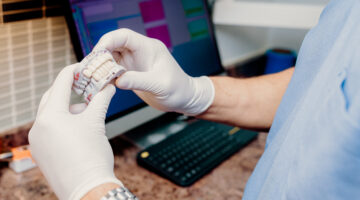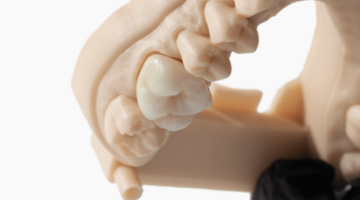New dental implant technology has transformed how dentists, orthodontists and periodontists approach patient care, especially when it comes to implant surgery. Advanced technologies and techniques help dentists perform complex procedures with greater accuracy, precision and safety. Today, it’s easy to provide patients with the best dental implant care through digital dentistry.
A brief history of dental implants
The development of implants is considered one of the most important advances in dentistry in the last four decades. In ancient times, it was common for missing teeth to be replaced by extracted human teeth or animal teeth, although rejection and infection often occurred. Other materials used for implants found in ancient skulls include jade, sea shells and rare gems.
In 1952, Dr. P. Branemark, an orthopedic surgeon, discovered the properties needed for successful fusion. By placing titanium chambers in their rabbit femur bone to study blood flow the doctor discovered that the chamber became firmly affixed to the bone, over time. In 1965, Dr. Branemark placed the first titanium dental implant in a human volunteer.
Today, implants are the standard of care for replacing missing teeth allowing patients to live as though they had their original teeth.
How have implant materials changed with new dental implant technology?
Over the years, dental implant professionals and manufacturers have improved the balance between improving contact with the surrounding bone, the distribution of loading stress, and the ease of treatment.
The oldest recorded dental implant patent in 1909 lists the use of non-corrosive implant materials like gold, silver, platinum or porcelain. Patents published in the 1960s list metal materials like stainless steel, cobalt/chromium alloys and titanium.
Due to its excellent biocompatibility, osseointegration, biocompatibility, mechanical properties and corrosion resistance, titanium has been the best choice in implant materials, like custom abutments, in recent years.
Now, non-titanium implant materials like zirconia ceramic and the fusion of various materials are the most patented implant material.
How has implant workflow changed with new dental implant technology?
Implant workflow—the old way
Usually, implant cases start by taking an analog impression. The impression is sent to the dental lab where they would fabricate the abutment, crown, and insert a post. Often, lab techs would correct impressions from dentists who failed to consider prosthetic requirements while planning. Most tools available to lab techs were designed to fix mistakes—not prevent them.
Today’s cutting-edge digital workflow
Now, instead of the analog process, intraoral scanning provides highly accurate information about a patient’s dentition and soft tissue. Advanced dental implant technology involves digital impressions, design software and surgical guides. The modern digital workflow eases the stress of accurate implant planning and placement.
Freehand Implant Surgery vs guided Implant Surgery
The other major shift in accuracy comes from the application. For years the modus operandi was for the doctor to “freehand” the surgery—eyeball the entry points and angles. Now with digital dentistry, partners like Dandy, will 3D-print a surgical guide that you can insert in your patient’s mouth. This ensures you have a bespoke template in a very specific, pre-planned location to give the most ideal depth, angulation, and size of implant to fit the area.
Guided implant surgery with Dandy
By utilizing Dandy for guided surgery, the entire implant process, from planning to placement to restoring can seamlessly occur all in one place. You have full collaboration from our expert implant planning team.

How has new dental implant technology changed Implant Surgery?
New dental implant technology has made the implant process easier, more comfortable, and more effective for the patient and practitioner–more than ever before. Below are a few ways modern dental implant technology has improved patient satisfaction.
Faster healing
New dental implant technology offers quicker healing times. Due to the development of new implant materials and techniques like immediate load implants, patients can have implants placed, heal quicker and use them sooner.
Enhanced accuracy, precision and durability
Improvements in computer-assisted technology and digital imaging have improved the accuracy of dental implant placement. Implants can placed in the precise position for the patient’s bite and jaw structure, leading to improved long-term results.
New implant materials like zirconia and titanium abutments are highly durable and last several years with proper care. The patient can enjoy the benefits for a longer time with no worries about failure or replacement.
More comfortable
New dental implant technology makes the process more comfortable for patients. Patients often resume their daily activities soon after surgery.
Improved aesthetics
New dental implant technology offers a more natural-looking result for patients. Dental implants can be made to match the color and shape of the patient’s natural teeth, improving their appearance.
CBCT scans and dental Implant treatment
An essential part of implant treatment, CBCT scans are used to take a virtual model of the patient’s teeth, bones and soft tissues and provide better results compared to traditional dental X-rays.
CBCT scans assist dental practitioners by:
- Designing an accurate bite while reducing the risk of misalignment
- Accurately measure and localize the available jawbone, and locate the maxillary sinus and sensory nerves
- Selecting the correct size and length of implant for the best stability and integration
Intraoral scanners
Taking physical impressions the traditional way can be uncomfortable for patients and time-consuming for dentists. Intraoral scanners (IOS) are digital devices for capturing direct digital impressions to fabricate prosthetic restorations such as posts and cores. Intraoral scanners eliminate the need for pouring a cast and saves time waiting for a plaster mold to arrive from the lab. IOS is also used in modern implant dentistry for guided surgery.
Computer-guided Implant Surgery
New dental implant technology has revolutionized the planning and placement of dental implants. Today, digital devices increase the accuracy of placement and reduce surgery time. Computer-generated treatment plans are now taking treatment from the computer directly to the patient. Advances in imagery, implant planning software and related surgical instrumentation, offer precise treatments, which improve patient care.
Why choose Dandy for digital treatment planning and guided implant surgery?
What our customers say:
“I’ve been working with Dandy’s Implant Surgery team for 1 year. They understand my process and have produced customized surgical guides for me and my patients. The guides fit well and work exactly as planned. Dandy’s understanding of the digital process is expert.” —Dr. Lee Maniscalco, MD DMD. Gonzalez and Maniscalco Oral & Facial Surgery, Birmingham, AL
Our cutting-edge dental implant lab technology and experienced CDT team help dentists plan the best implant treatments for their patients.
Dandy’s computer-guided implant surgery planning, surgical guides, and dedicated CDT team help general dentists offer implant services and perform implant surgery—improving practice revenue, clinical outcomes, and patient satisfaction.
Subscribe to our newsletter!
We send emails on Tuesdays. Keep an eye out for the next one!
Sources:
https://www.mouthhealthy.org/all-topics-a-z/implants
https://www.ncbi.nlm.nih.gov/pmc/articles/PMC4040928/
https://biomaterialsres.biomedcentral.com/articles/10.1186/s40824-022-00307-0
https://www.dentalproductsreport.com/view/how-technology-changing-implant-workflow



